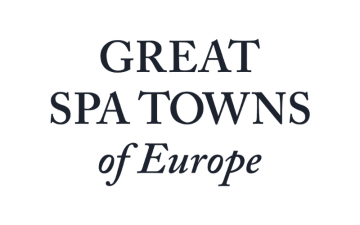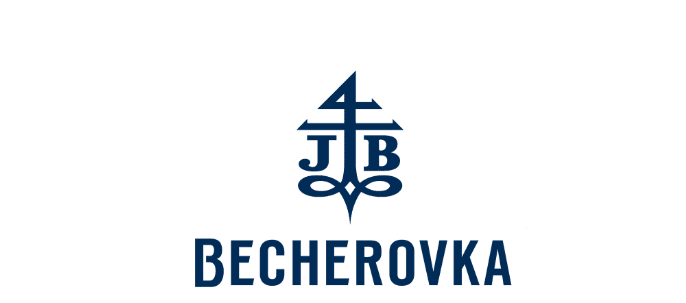HOTEL HISTORY
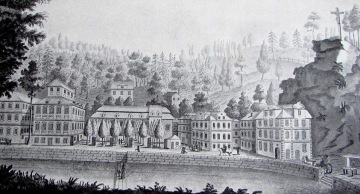
The reference of three centuries
The Grandhotel Pupp boasts such a fascinating history as few other hotels in the world. Historical twists, revolutions, wars and disputes of ancient owners have failed to break the thread of a unique story that has been going on for more than three centuries.
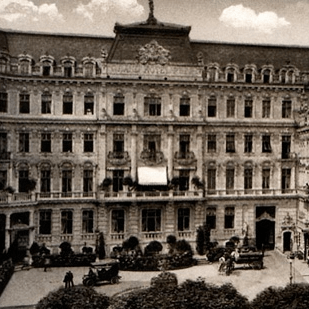
1701
The beginning of its history:
the creation of the Saxon Hall
The mayor of Karlovy Vary, Anton Deiml, built a ballroom for the noble clientele of Karlovy Vary, the so-called Salle de l’Assemblée. Saxon Elector Friedrich August contributed to his construction, and the operating staff always arrived from Leipzig for the season, making it the Saxon Hall.
1708
Construction of the Czech Hall
Another of the Karlovy Vary mayors, Andreas Wenzel Becher, a competing company Becheres Lusthaus built on the opposite plot. The seasonal staff here came mostly from Prague, so the name Czech Hall soon established itself.
Both halls, which were perpendicular to each other in the bend of the valley of the Teplá River, together with the later built House U Božího oka, became the basis of today's Grandhotel Pupp, whose current building has replaced them all.
1717
The wooden theater of the Elector
of Saxony
The Elector of Saxony, August Silný, had the so-called Comödien Haus built next to the Saxon Hall, a wooden building that hosted theatrical performances, concerts and many other type sof entertainment.
1730
Building the House of God's Eye
This house, wedged between the Czech and Saxon Hall, belonged to the Deiml family for many years and was bought for the hotel's needs two centuries later.
1759
Great Fire of Karlovy Vary
Karlovy Vary suffered a devastating fire that hit the then Karlovy Vary City Hall. Therefore, the City Council's meetings took place in the Czech Hall for the following years. At that time, very little was happening and the monastery could have been a hotel instead. The Order of the Merciful Brothers showed interest in buying the Czech Hall and its reconstruction, which fortunately the owners and Karlovy Vary councilors refused.
1767
The beginning of the Pupp dynasty
Mitterbach, a renowned confectioner, employed a young confectioner in his business, who had previously worked for Count Chotek. Jan Jiří Pop (1743 - 1810), a native of Central Bohemia, settled in Karlovy Vary, and when he was 32 years old he married Mitterbach's daughter Franziska. Because the Carlsbad honor was exclusively German at that time, he used the German variation of his name, and he signed it as Johann Georg Pupp.
1778
The family and the place join: The Czech Hall is buying the Pupp
Mr. and Mrs. Pupp became the owners of the Czech Hall. First, in 1775, Franziska bought Anna Becher's third, a year later she bought Josefa Becher's third, and in 1778 Johann Georg Pupp bought the remaining stake from Marie Ihl. The new owners trasformed the park landscape with Linden trees, the so-called Pupp's Alley, which quickly became a popular spa promenade.
1801
Opening the first restaurant
in Karlovy Vary
Philipp Valentin Keil opened the first publicly accessible restaurant in Karlovy Vary, the so-called Freitafel, in the Saxon Hall. He did so in response to the successful operation of the Czech Hall under the baton of the Pupps, which by its popularity, completely overshadowed the older Saxon Hall.
1821
The biggest Karlovy Vary flood
in the 19th centu
The night of the 10 th of September was hit by a devastating flood in Karlovy Vary. The Teplá River, engorged by heavy rains, flooded and completely destroyed the ground floor of the Czech and Saxon Halls. The beautiful linden alley, which was the pride and joy of the park for almost a century, was hit with a severe blow. The trees began to gradually die, and the entire alley had to be cut down.
1822
Rebirth
The removal of the flood damage, required extensive repairs to both the Saxon and the Czech Halls, which despite their proximity still represented competitive business. Both halls quickly recovered from the element's rampage and once again became the center of spa entertainment.
1828
The Czech Hall temporarily out of the control of the Pupp family
The protracted dispute among Johann Georg Pupp's descendants meant a disaster. Although the court eventually ruled in favor of Barbara, his daughter-in-law, she was in debt because of the dispute and had to sell the Czech Hall. Fortunately, it was purchased by related families.
1833
The first major reconstruction
of the Czech Hall
The more than 100-year-old building required renovation and new equipment.
1868
Czech Hall again in the hands of the Pupps
The brothers Anton, Julius and Heinrich, members of the fourth generation of the Pupp family, together with their mother, become full owners of the Czech Hall after 40 years. Through sophisticated purchases, they gradually acquire strategic homes and land around it.
1872
New owners of the Saxon Hall
The Saxon Hall was bought by the Heidinger family, the owners of a prosperous porcelain factory in nearby Loket.
1877
Building the Parkhotel
The Pupp brothers started construction of the Parkhotel building, the first section of today's Pupp. Because of its great success, it expanded with another wing in the coming years.
1890
Purchase of the Saxon Hall
The Pupp family purchased the Saxon Hall, a competing enterprise. In the meantime, they prepared to radically rebuild the entire complex which was already quite outdated.
1892
Laying the foundation stone of a new building
This was the year of the birth of the modern Grandhotel Pupp. In November, the demolition of the Czech and Saxon Halls were launched, replaced by a new building, designed by the Viennese architects Robert Příhoda and Josef Němeček. It was built roughly on the same spot as the halls, and it still maintains the same face and layout till this day. For an idea, the Festive Hall stands on the site of the original Pupp's Alley, Café Pupp occupies the space of the original House of God, the Czech Hall, perpendicular to the Saxon Hall, are on the site of today's Riverside Building. On the site of historic houses adjacent to the Saxon Hall, you will find the Harp building.
1894
New grand opening
Grandhotel Pupp
The grand opening of the newly completed hotel was held on May 13 th coinciding with the opening of the spa season. The Grandhotel Pupp immediately became the pride of Karlovy Vary, and soon began to host the most important personalities from around the world.
1907
Neo-Baroque reconstruction
The Viennese architects Ferdinand Fellner and Hermann Helmer, the designers of the Zurich Opera, the Salzburg Theater and the original Hot Spring Colonnade, unified the hotel's facades in a monumental Neo-Baroque style. The entire reconstruction took almost three years.
1923
Bathroom in every room
An extensive alteration of the hotel's accommodation area was completed. Each room was upgraded to the highest standards of the day, and equipped with a toilet and a bathroom with hot water.
1934
Buying the house of God's Eye
The family bought the house of God Eye at auction, which all previous generations of Pupps tried without success. The house was torn down, and an additional hotel was built in its place, with the Café Pupp located on the ground floor.
1938
Karlovy Vary connected to Germany
A year after the last pre-war repairs to the hotel, the Czechoslovakian border area, the so-called Sudetenland, was annexed to Germany in the Munich Agreement. During this time the hotel was presented as the Grand- und Park- Hotel Pupp.
1944
The consequences of the war
With the deteriorating military situation in Germany, Karlovy Vary became a hospital town, where the officers' hospital took up most of Pupp. The then director Heinrich Gerlach, was taken by the army, and in addition to managing the hotel, whose operation was already severely limited, he worked as an ambulance officer in nearby Dvory. The German army also confiscated 5 tons of coffee for the Luftwaffe pilots and submarines sailors.
1945
Nationalization of the hotel and the end
of the Pupp dynasty in Karlovy Vary
The Grandhotel Pupp and most of the spa part of the city survived the war without much damage. At the end of the war, the demarcation line between the Allied and Soviet troops led through the city, with the troops leaving the city in November. The farewell ceremony was held at Pupp, already nationalized. The nationalization and removal of the German population in 1945 also marked the end of the Pupp dynasty in Karlovy Vary.
1950
Karlovy Vary Film Festival
In 1950 Karlovy Vary became the venue for the festival, which was previously shared with Mariánské Lázně. The Grandhotel Pupp has since been used to accommodate the most important festival guests.
1951
Grandhotel Moskva
The symbolic point behind the Pupp family was renaming the Grandhotel Moscow. The clientele changed, the hotel was filled with recuperating workers, peasants and Czechoslovakian army generals, and the luxury suites were enjoyed by communists.
1957
Flashing for better times
The need for hard currency and the partial release of international tensions led to the gradual return of traditional clientele. Again, visitors from outside the Eastern Bloc started to dominate, as did gastronomy and cultural offerings.
1960
The largest accommodation capacity
in the history of the hotel
The Grandhotel Moskva with all its dependencies had a capacity of 1080 beds, and during the ball season held more than 20 balls. However, there was a lack of maintenance and investment and it began to show.
1964
Return to the top
The extensive reconstruction started in 1964 lasting 4 years and returning the hotel to its former glory and fame. The level of accommodation and gastronomy was comparetive to the world's best hotels of that time.
1968
Occupation of Czechoslovakia
The further development of Karlovy Vary and the Grandhotel was hampered by the occupation of Czechoslovakia by the Warsaw Pact troops, after which relations with the West again cooled significantly. Although the hotel continued to focus on solvent foreign clientele, but the important guests decreased.
1989
Velvet Revolution in Czechoslovakia
The end of 1989 brought the fall of communism throughout Eastern Europe. Already in November, a few days after the beginning of the Czechoslovakian Velvet Revolution, the name of the Grandhotel Pupp returned to the hotel facade.
1992
New beginning
After the transformation of the state hotel into a joint stock company, it was settled with the Pupp family and an agreement on the use of the traditional trademark Grandhotel Pupp was concluded.
1994
Hotel movie stars
Czech actor Jiří Bartoška becomes the president of the film festival and launches his most famous era. Although the Grandhotel Pupp has always been the home of the most important festival guests, only the stars of the world have come regularly since that year. Hundreds of actors, directors and other famous filmmakers have gone through the hotel corridors over the years, including Renee Zellweger, Jamie Dornan, Salma Hayek, John Travolta, Milos Forman and Robert Redford.
2006
James Bond
"Last holiday" straring Queen Latifah with Gérard Dépardieu and the Bond series- Casino Royale staring Daniel Craig and Eva Green took place at the hotel, which is connected with the film thanks to the Karlovy Vary festival.
2012
Discovering the Franziska bath
During the construction of the hotel spa, we discovered a real treasure - glass bottles with historical documents, including a recipe for a relaxing bath created by Franziska Pupp, the wife of the founder of our hotel, Johann Georg Pupp. Thanks to this, our guests can indulge in a more than 200-year-old herbal treatment even today.
2013
Own top-quality balneo center
and swimming pool
The Pupp Royal Spa, a unique luxury wellness and balneo center, was opened, thanks to which the Grandhotel Pupp can provide its own spa treatment.
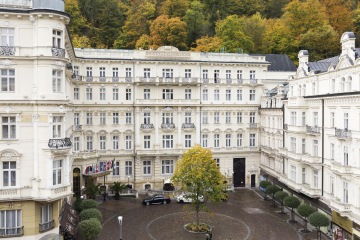
2019
There was a great reconstruction of the Small Hall, which turned the lobby bar into a restaurant with a central bar made of Czech crystal and slices of pure gold. The atmosphere of the space is underscored by the photographs of stars, created by Tono Stano in Pupp.

